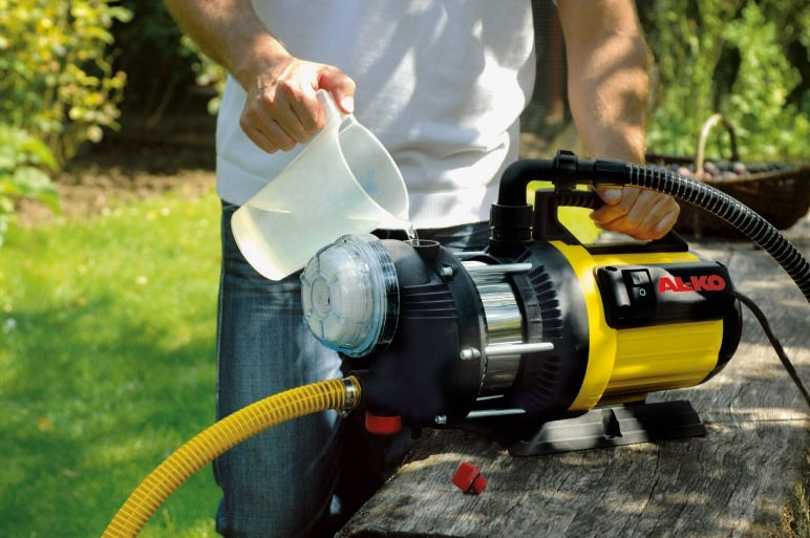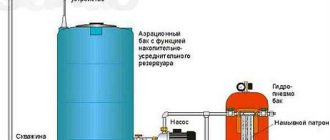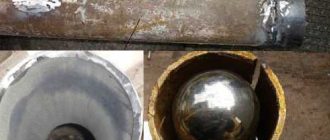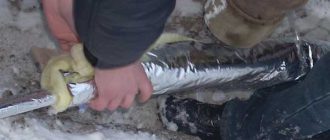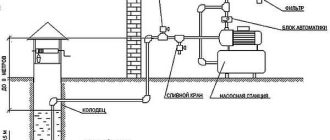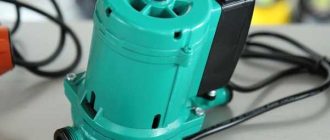Pumps are used to supply water to the house or to water the vegetable garden. There are different types and designs, and each of them finds its own area of application. If you need an inexpensive and reliable device for pumping water from a well, well or some container, pay attention to the self-priming pump. These are relatively inexpensive devices that are installed on the surface, pump water can pump water from a fairly decent depth – 8-9 meters. If necessary, models are supplemented with ejectors, then the depth of suction increases to 20-35 m.
محتويات المقال
Self-priming pumps: device and types
Self-priming pumps pump water from a depth of 8-9 meters, while being on the surface. Water rises due to the fact that in the central part of the body, due to the movement of wheels with paddles, a low-pressure area is created. In an effort to fill it, the water rises upwards. It turns out that the pump sucks water.
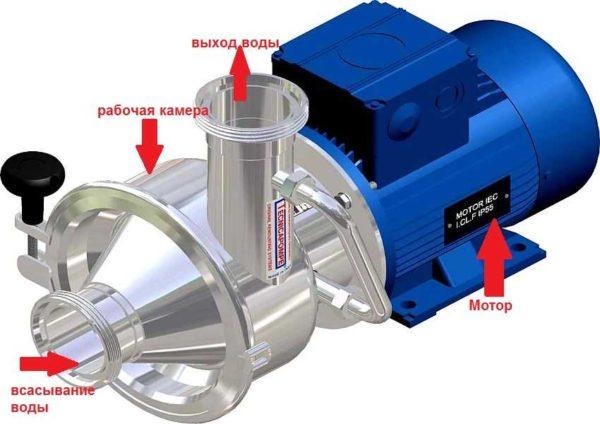
Like any other pump, the self-priming pump consists of a motor and a working chamber, in which the discharge mechanism is located. The pump and motor shafts are connected through a coupling, the reliability of the connection and tightness is determined by the type of seal.Sealers are of two types:
- gland seal – cheaper and less reliable;
- mechanical seal – more reliable but expensive.
There are models of self-priming pumps with magnetic couplings. They do not require sealing, as they have no through connections. This is by far the most reliable design, but it is also the most expensive.
Construction and operating principle
According to the method of action, a self-priming pump can be vortex and centrifugal. In both, the key link is the impeller, but it has a different structure and is installed in a housing of different shape. This changes the principle of operation.
Centrifugal
Centrifugal self-priming pumps have an interesting structure of the working chamber – in the form of a snail. In the center of the casing are fixed impellers. The wheel can be one, then the pump is called single-stage, there can be several – multistage design. Single-stage always work at the same power, multistage can, depending on conditions, change the performance, respectively, are more economical (less power consumption).
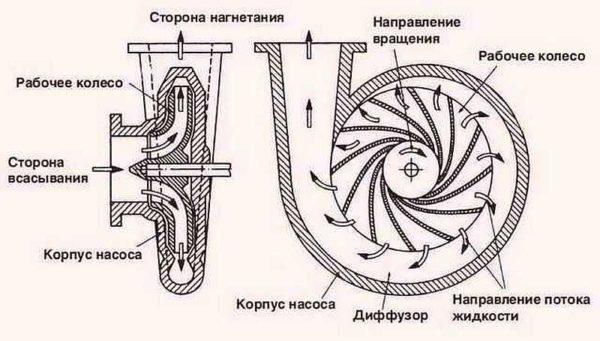
The main working element in this design is a wheel with vanes. The vanes are bent in the opposite direction to the movement of the wheel. As they move, they push the water against the walls of the casing. This phenomenon is called centrifugal force, and the area between the blades and the wall is called the “diffuser”. So, the impeller moves, creating an area of increased pressure at the periphery and pushing the water towards the outlet.
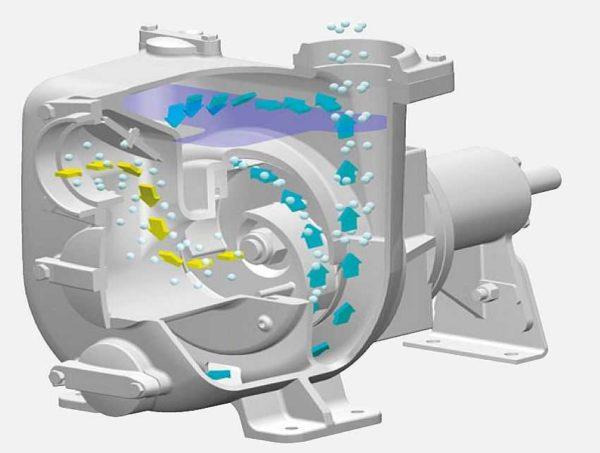
At the same time, a low-pressure zone is formed in the center of the impeller. Water is sucked into this area from the supply pipe (suction line). In the illustration above, the incoming water is indicated by yellow arrows. It is then pushed against the walls by the impeller and rises to the top due to centrifugal force. This process is constant and endless, repeating as long as the shaft is turning.
With the principle of action of centrifugal pumps is associated with their disadvantage: to create centrifugal force from the air impeller can not, because before the work the case is filled with water. Since pumps often work in intermittent mode, so that the water does not flow out of the casing when stopping, on the suction pipe put a check valve. These are such features of the operation of centrifugal self-priming pumps. If the check valve (it must be mandatory) on the supply pipe is at the bottom, you have to fill the entire pipeline, and for this you will need more than one liter.
| Name | Capacity | Head | Maximum suction depth | Performance | Housing material | Connection dimensions | Price |
|---|---|---|---|---|---|---|---|
| Kalibr NBTS-380 | 380 W | 25 м | 9 м | 28 l/min | cast iron | 1 inch | 32$ |
| Metabo P 3300 G | 900 W | 45 м | 8 м | 55 l/min | cast iron (stainless steel drive shaft) | 1 inch | 87$ |
| ZUBR ZNS-600 | 600 W | 35 м | 8 м | 50 l/min | plastic | 1 inch | 71$ |
| Elitech NS 400V | 400W | 35 м | 8 м | 40 l/min | cast iron | 25 mm | 42$ |
| PATRIOT QB70 | 750 W | 65 м | 8 м | 60 l/min | plastic | 1 inch | 58$ |
| Jilex Jumbo 70/50 Ch 3700 | 1100 W | 50 м | 9 m (built-in ejector) | 70 l/min | cast iron | 1 inch | 122$ |
| BELAMOS XI 13 | 1200 W | 50 м | 8 м | 65 l/min | stainless steel | 1 inch | 125$ |
| BELAMOS XA 06 | 600 W | 33 м | 8 м | 47 l/min | cast iron | 1 inch | 75$ |
Vortex
The vortex self-priming pump is characterized by the structure of the casing and impeller. The impeller is a disk with short radial baffles located at the edges. It is called impeller.
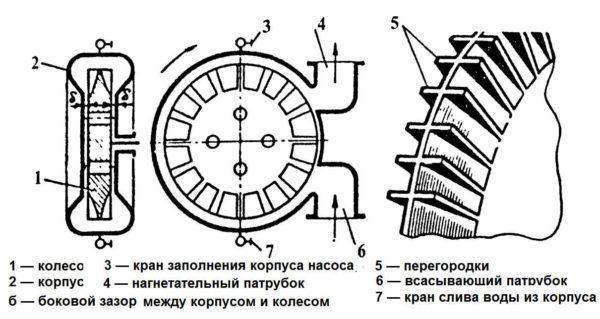
The casing is made so that it quite tightly covers the “flat” part of the impeller, and in the area of the baffles there is a significant lateral gap. As the impeller rotates, water is entrained by the baffles. Due to the action of centrifugal force, it is pushed back to the walls, but after some distance it again enters the zone of action of the baffles, receiving an additional portion of energy. Thus, in the gaps it is also twisted into vortices. The result is a double vortex flow, which gives the equipment its name.
Due to the way they work, vortex pumps can generate 3-7 times more pressure than centrifugal pumps (at the same wheel size and rotational speed). They are ideal when low flow and high pressure are required. Another plus is that they can pump a mixture of water and air, sometimes even creating rarefaction if they are filled with air only. This makes it easier to get it up and running – you don’t have to fill the chamber with water or a small amount of water is enough. The disadvantage of vortex pumps is low efficiency. It cannot be higher than 45-50%.
| Name | Capacity | Head (lift height) | Capacity | Suction depth | Housing material | Price |
|---|---|---|---|---|---|---|
| LEO XKSm 60-1 | 370 W | 40 м | 40 l/min | 9 м | cast iron | 24$ |
| LEO XKSm 80-1 | 750 W | 70 м | 60 l/min | 9 м | cast iron | 89$ |
| AKO QB 60 | 370 W | 30 м | 28 l/min | 8 м | cast iron | 47$ |
| AKO QB 70 | 550 W | 45 м | 40 l/min | 8 м | cast iron | 68 $ |
| Pedrollo RKm 60 | 370 W | 40 м | 40 l/min | 8 м | cast iron | 77$ |
| Pedrollo RK 65 | 500 W | 55 м | 50 l/min | 8 м | cast iron | 124$ |
Ejector
The greatest depth from which surface vortex and centrifugal pumps can lift water is 8-9 meters, often it is located deeper. To “extract” it from there, pumps are equipped with an ejector. This is a tube of a special shape, which, when water moves through it, creates a discharge at the inlet. So such devices also belong to the category of self-priming. Ejector self-priming pump can lift water from a depth of 20-35 meters, and this is more than enough for most sources.
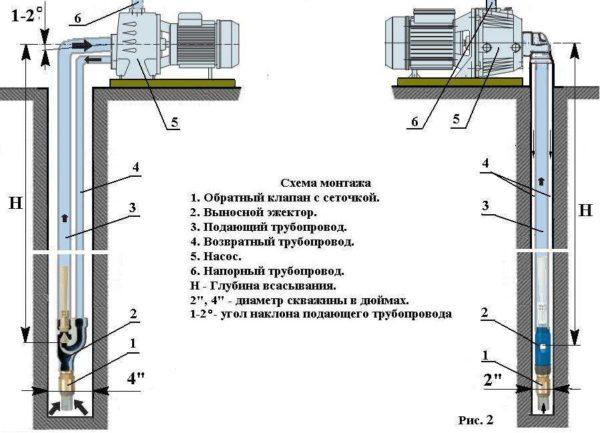
The disadvantage is that to ensure operation, part of the realized water must be returned back, therefore, the performance is significantly reduced – such a pump can provide not a very large flow rate of water, but electricity to ensure operability is spent no less. When installing the injector in a well or a well of sufficient width, two pipelines are lowered into the source – one supplying a larger diameter, the second, return, smaller. The ejector is connected to their outlets, and a filter and check valve are installed at the end. In this case, the disadvantage is also obvious – double pipe consumption, and therefore – a more expensive installation.
In small-diameter wells, one pipeline is used – the supply pipe, and instead of the return pipe the well casing is used. In this way a rarefaction zone is also formed.
Vortex and centrifugal – comparison and scope of application
First, the common features:
- maximum suction depth – 8-9 meters;
- the installation method is surface mounted;
- on the suction pipe should be a pipe or reinforced hose (do not put the usual, it will be flattened by negative pressure).
Now about what are the differences between vortex and centrifugal models. Vortex pumps are more compact, cost less, but make more noise when working. Centrifugal pumps are quieter and produce low pressure at the outlet. Vortex pumps with the same impeller size and speed of its rotation can create pressure 3-7 times more. But we cannot say that this is their advantage – far from always requires a large pressure at the outlet. For example, it is not needed when watering the garden and vegetable garden. Water supplied with high pressure will simply wash away the soil, expose the roots. Therefore, as a pump for irrigation is better to take a self-priming pump of the centrifugal type.
High output pressure may be required when organizing a water supply system at home. This is where the characteristics of vortex pumps are required. There is only one disadvantage: they can not provide a large flow rate. So more often for these purposes use the same centrifugal, but paired with a hydroaccumulator. True, then it turns out to be a pumping station.
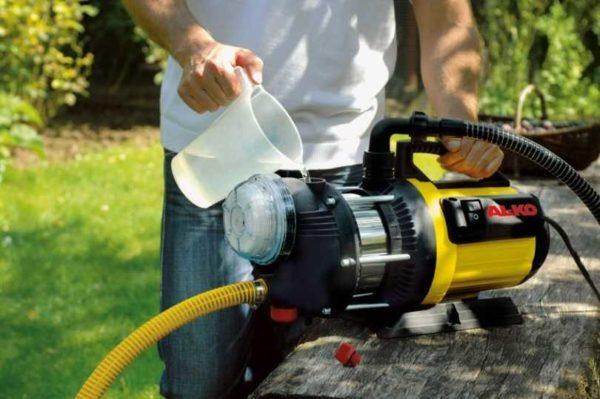
The main disadvantage of surface centrifugal self-priming pumps is the need to fill them with water before starting. Not the most pleasant thing to do, which adds to the hassle of using such a pump for irrigation.

